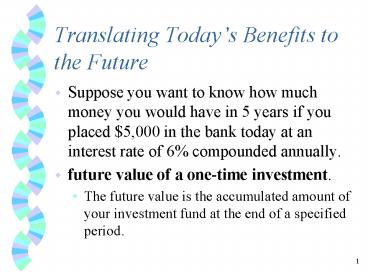Translating Today - PowerPoint PPT Presentation
1 / 17
Title:
Translating Today
Description:
Translating Today s Benefits to the Future Suppose you want to know how much money you would have in 5 years if you placed $5,000 in the bank today at an interest ... – PowerPoint PPT presentation
Number of Views:63
Avg rating:3.0/5.0
Title: Translating Today
1
Translating Todays Benefits to the Future
- Suppose you want to know how much money you would
have in 5 years if you placed 5,000 in the bank
today at an interest rate of 6 compounded
annually. - future value of a one-time investment.
- The future value is the accumulated amount of
your investment fund at the end of a specified
period.
2
- This is an exercise that involves the use of
compound interest. - Compound interest - Situation where you earn
interest on the original investment and any
interest that has been generated by that
investment previously. - Earn interest on your interest
- First year 5,000(1.06) 5,300
- Second year 5,300(1.06) 5,618
- Third year 5,618(1.06) 5,955.08
- Fourth year 5,955.08(1.06) 6,312.38
- Fifth year 6,312.38(1.06) 6,691.13
3
Effect of Compound Interest
4
- Formula
- FV PV(1 r)n
- r interest rate divided by the compounding
factor - (yearly r / compounding factor)
- n number of compounding periods
- (yearly n compounding factor)
- PV Present Value of your investment
- Compounding Factors
- Yearly 1
- Quarterly 4
- Monthly 12
- Daily 365
5
- Please note that I will always report rs and ns
as yearly numbers - You will need to determine the compounding factor
- All of your terms must agree as to time.
- If you are taking an action monthly (like
investing every month), then r and n must
automatically be converted to monthly
compounding. - If you are rounding in time value of money
formulas, you need AT LEAST four (4) numbers
after the zeros (0) - r .08/12
- r0.006667 (not 0.0067 or 0.007 or etc.)
6
- Yearly compounding
- PV 5000
- r .06
- n 5
- FV 5,000(1.06)5
- 6,691.13
- Monthly compounding
- PV 5000
- r (.06/12) .005
- n 5(12) 60
- FV 5,000(1.005)60
- 6,744.25
7
Implications
- _____ frequency of compounding ___ FV
- _____ length of investment ____ FV
- _____ interest rate _____ FV
8
How do the calculations change if the investment
is repeated periodically?
- Suppose you want to know how much money you would
have in 24 years if you placed 500 in the bank
each year for twenty-four years at an annual
interest rate of 8. - future value of a periodic investment or future
value of an annuity (stream of payments over
time) FVA
9
The formula is...
- where PV the Present Value of the payment in
each period - r interest rate divided by the compounding
factor - n number of compounding periods
10
Lets try it
- 500/year, 8 interest, 24 years, yearly
compounding - PV 500
- r .08
- n 24
- 500 (66.7648)
- 33,382.38
11
Lets try it again
- 50/month, 8 interest, 5 years, monthly
compounding - PV 50
- r (.08/12) .006667
- n 5(12) 60
12
- 50 (73.4769)
- 3673.84
- Try again with n120
- FVA9147.30
13
More Practice
- You have a really cool grandma who gave you
1,000 for your high school graduation. You
invested it in a 5-year CD, earning 5 interest.
How much will you have when you cash it out if it
is compounded yearly? - How much will you have if it is compounded
monthly? - How much will you have if it is compounded daily?
14
- Yearly Compounding
- 1,000(1.05)5
- 1,276.28
- Monthly Compounding
- r (.05/12) .004167
- n 5(12) 60
- 1,000(1.004167)60
- 1,283.36
- Daily Compounding
- r (.05/365) .000136986
- n 5(365) 1,825
- 1,000(1.000136986)1825
- 1,284.00
15
Some more practice...
- You have decided to be proactive for the future,
and will save 25 a month. At the end of 10
years, how much will you have saved, if you earn
8 interest annually? - Monthly Compounding
- FVA
- PV 25 a month
- r (.08/12) .006667
- n (10)(12) 120
- FVA 4,573.65
16
(No Transcript)
17
Rule of 72
- A handy formula to calculate the number of years
it takes to double principal using compound
interest is the Rule of 72. You simply divide
the interest rate the money will earn into the
number 72. For example, if interest is
compounded at a rate of 7 per year, your
principle will double every 10.3 years. If the
rate is 6 , it will take 12 years.The rule of 72
also works for determining how long it would take
for the price of something to double given a rate
of increase in the price. For example, if
college tuition costs are rising 8 per year,
the cost of college education doubles in just
over nine years.































